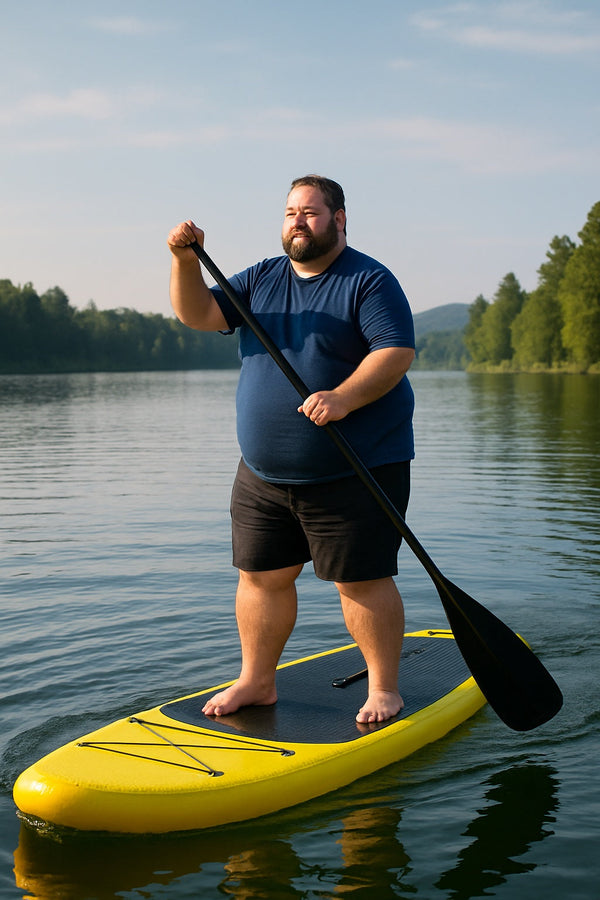
SUP for Larger Paddlers: How to Choose the Right Paddle Board and Get Started
Stand up paddleboarding (SUP) is for everyone, no matter your size or body type. Whether you're looking for a new way to stay active, enjoy nature, or simply have fun on the water, there is a paddle board that can match your needs.
Stand up paddleboarding (SUP) is for everyone, no matter your size or body type. Whether you're looking for a new way to stay active, enjoy nature, or simply have fun on the water, there is a paddle board that can match your needs.
If you are a larger paddler, you might have a few extra things to consider when choosing your gear and getting started. In this guide, we’ll cover everything you need to know to find the right SUP, feel confident, and enjoy every minute on the water.
Why Paddleboarding Is Perfect for Larger Paddlers
SUP is a low-impact, full-body workout that strengthens your core, improves balance, and reduces stress. Unlike some other outdoor sports, paddle boarding offers flexibility—you can stand, kneel, sit, or even lie down on your board. The activity can be as relaxed or as challenging as you want it to be.
Many modern paddle boards are designed to handle higher weight capacities, offer exceptional stability, and provide a smooth, enjoyable ride regardless of your size.

What to Look for in a Paddleboard for Larger Paddlers
Choosing the right board is the most important step to ensure comfort, stability, and performance on the water. Here’s what you should focus on:
1. Weight Capacity
Always check the board’s weight limit. You want a paddleboard that supports your body weight plus any extra gear (like coolers, dry bags, fishing gear, or pets).
-
Look for boards rated to hold at least 300 pounds.
-
If you plan to bring gear, aim for a board rated 20 to 30 percent higher than your total combined weight.
Boards like the Glide O2 Angler 2.0 and the Glide O2 Quest offer generous weight capacities for larger paddlers or those carrying extra gear.
2. Width for Stability
Board width is crucial for balance. Wider boards are more stable, especially when starting out.
-
Look for boards that are at least 32 inches wide, ideally 34 to 36 inches.
-
Wider boards make standing, paddling, and even turning much easier for heavier paddlers.
3. Thickness and Volume
-
A 6-inch-thick board is ideal for most larger paddlers, offering greater buoyancy and minimizing flex.
-
Volume (measured in liters) reflects how much water the board displaces. Higher volume equals better flotation. Aim for at least 250 liters or more, depending on your weight and intended gear load.
4. Board Shape
-
All-around boards are great for beginners and casual paddlers.
-
Touring boards are longer and narrower, offering better glide but requiring a bit more balance.
-
Fishing or adventure boards often offer the highest stability and gear capacity.
Inflatable boards are often preferred because they are forgiving underfoot, easier to transport, and offer excellent durability.
Best Types of Paddleboards for Larger Paddlers
While many companies market boards as “universal,” some models are truly designed to handle larger riders:
-
Fishing SUPs: Built wider and heavier-duty for maximum stability.
-
Adventure SUPs: Designed for long trips, these boards prioritize carrying capacity.
-
Extra-Wide All-Around SUPs: Great for beginners seeking maximum balance.
Examples include high-capacity boards like the Glide O2 Angler and O2 Retro, both of which combine stability, rugged construction, and excellent flotation.
Tips for Paddleboarding as a Larger Beginner
Starting out on the water is easier when you set yourself up for success. Here are some practical tips:
Start on Calm Water
Flatwater lakes, calm bays, or slow rivers are perfect for building confidence before tackling wind, waves, or currents.
Kneel First, Then Stand
Start paddling from a kneeling position to get a feel for the board. Once you are comfortable with balance, move to a standing position gradually.
Distribute Your Weight Evenly
Stand with your feet hip-width apart, centered over the handle of the board. Keep your knees slightly bent and engage your core for better stability.
Use Proper Paddle Technique
Hold the paddle correctly—with the blade angled forward—and make long, efficient strokes close to the side of your board.
Relax and Stay Loose
Stiff legs and arms make balancing harder. Keep a relaxed, athletic stance and let your knees and ankles absorb small movements from the water.
Overcoming Common Concerns
Will the board sink under my weight?
Not if you choose a board designed for higher capacities. Always check the specifications and allow for some extra margin with gear.
Will I fall a lot?
Everyone falls when learning, regardless of size. Calm water, a wide board, and a patient mindset will minimize falls quickly.
Is paddleboarding good exercise for larger paddlers?
Yes. SUP provides excellent cardiovascular, core, and full-body conditioning while being easy on the joints compared to running or other high-impact sports.
Final Thoughts: Paddleboarding Is for Everyone
There is no "ideal" body type for stand-up paddleboarding. With the right board and a little patience, larger paddlers can have just as much success and enjoyment on the water as anyone else. Paddle boarding is about freedom, exploration, and finding joy in movement—not about fitting into a certain mold.
If you are ready to get started, explore our selection of stable, durable inflatable paddle boards designed to help every paddler, no matter their size, feel confident and at home on the water.
Stand tall. Paddle strong. The water is waiting for you.

